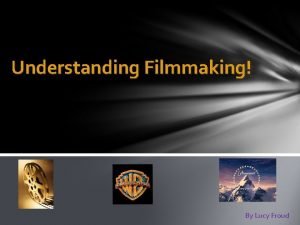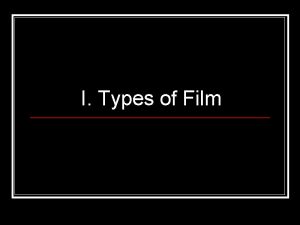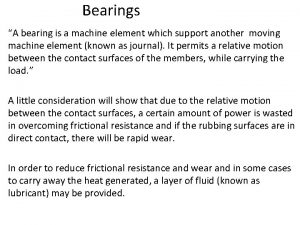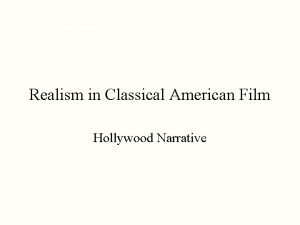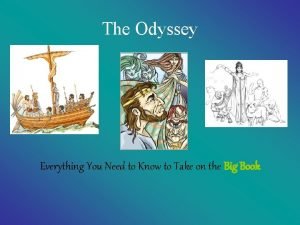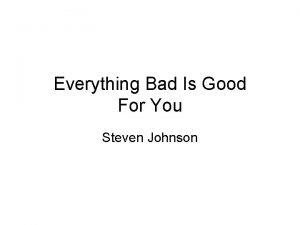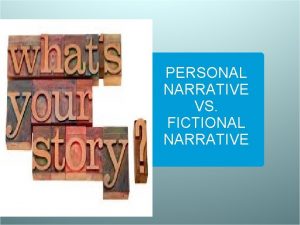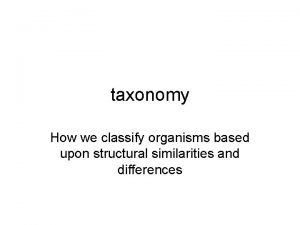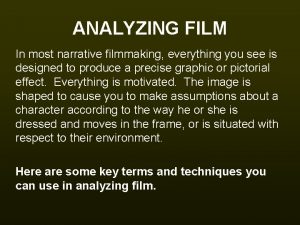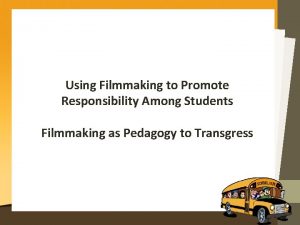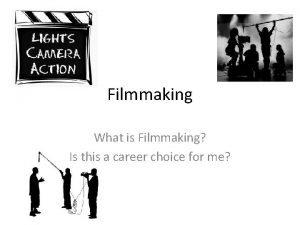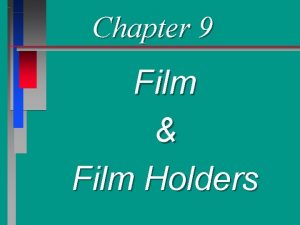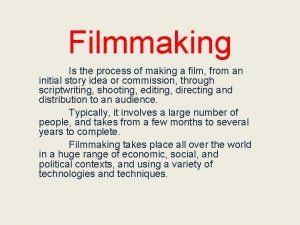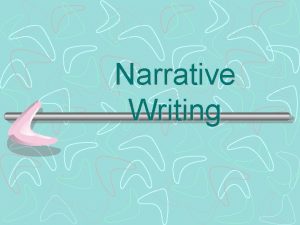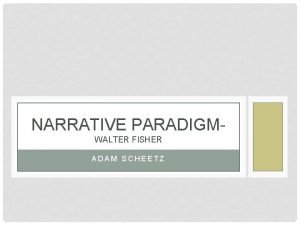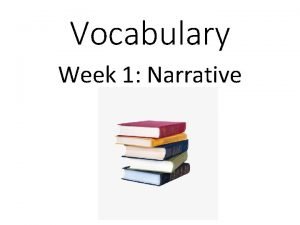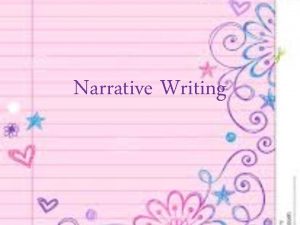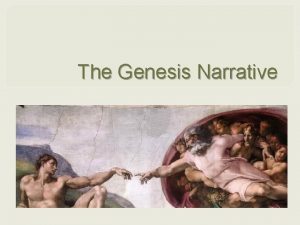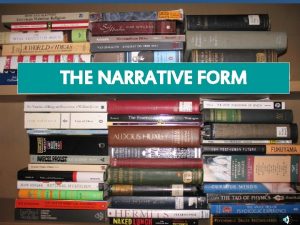ANALYZING FILM In most narrative filmmaking everything you






















- Slides: 22

ANALYZING FILM In most narrative filmmaking, everything you see is designed to produce a precise graphic or pictorial effect. Everything is motivated. The image is shaped to cause you to make assumptions about a character according to the way he or she is dressed and moves in the frame, or is situated with respect to their environment. Here are some key terms and techniques you can use in analyzing film.

NARRATIVE Questions to ask when discussing the narrative: • What is the chronological order of the film? Is it told in flashbacks, real time, or over an extended period of time? • Are there voice-overs or title cards to help narrate the film? What is the plot of the film? • Is the narrative conforming to the conventions of a specific genre? (Romance, Western, Crime? )

CHARACTER Analyzing Filmic Characters is similar to analyzing written characters: Are they realistic, how do they change over the course of the film, what do they represent etc. ? Types Of Characters: Round Characters – – Complex, life-like, multidimensional, and changeable Usually only a few per film Appear throughout the film Essential to the plot Flat Characters – Simple, stereotypical, minor, one-dimensional, unchanging – Appear only in a few scenes – Are rarely essential to the plot but add interest

Two Examples of Round Characters in The Matrix – Neo and Trinity __________________________________ Example of Flat Characters in The Matrix – extra agents who help Agent Smith

POINT OF VIEW (POV) • When is the POV objective (omniscient), and when is it subjective (seen through the eyes of one of the characters)? • What does this POV tell us about the characters? • How does the camera’s eye limit or control what you see? How do shifts in POV affect the viewer and the viewer’s understanding of the film?

Point of View How do the different POVs in these two images create interpretations? Subjective POV in The Matrix Revolutions (2003) Objective POV in The Matrix (1999)

MISE-EN-SCÈNE Literally means “put into the scene” and refers to sets and backdrops, the use of props and lighting, as well as the blocking of actors’ movements within the dramatic space. The term is used to describe the space constructed for the camera. It includes two important elements: 1. Setting 2. Composition

MISE-EN-SCÈNE: Setting • Lighting: is it harsh or soft? Tinted or colored? Natural or artificial? What shadows does it create? • Costumes: what do we learn about the characters from what they wear (or don’t wear)? • Sets: Are props or sets significant? How do characters relate to them? Are they related to any themes?

Setting: Lighting What is the effect of back-lighting in this image from The Lord of the Rings: The Two Towers (2002)? How does side lighting influence the interpretation of the frame? The Sixth Sense (1999)

Setting: Costumes may be used to distinguish main characters from secondary characters, to further the plotline, and to identify good and evil. Gone With the Wind (1939) Star Wars (1977)

Setting: Sets can reveal how a character has changed. In these two shots from American Beauty (1999), the setting echoes the changing relationship between Lester and his wife.

MISE-EN-SCÈNE: Composition Some questions to consider when analyzing composition: – The Arrangement: How are the elements in the frame arranged? (Foreground and Background) – Photographic qualities: Are the images grainy, distressed, crisp, or processed in a special way? – Framing: Do elements (besides the screen itself) confine/divide/exclude parts of the image? What is off -screen? How is space created or violated by the frame? – Camera angle, distance, and tilt: Does the camera itself move (tracking) or does it stand still and just rotate (a pan)?

Composition: Arrangement (Part 1) Foreground and Background How filmmakers position people and objects in the background and foreground in a given image influences what the image communicates. Harry Potter and the Chamber of Secrets (2002) The background of an action may go unnoticed because it is obscurely lit or out of focus or because subjects in the foreground draw so much of the viewer’s attention.

Composition: Arrangement Symmetrical Composition In symmetrical compositions, the subject(s) is seen in the approximate center of the frame. American Beauty (1999) Moulin Rouge (2001)

Composition: Arrangement Asymmetrical Composition In asymmetrical compositions, major subjects are not offset or balanced by other subjects elsewhere in the frame. Asymmetrical compositions can cause the viewer to pay attention to an aspect of the shot he or she might otherwise ignore. Thelma and Louise (1991)

Composition: Photographic Qualities of The Shot The grainy, washed-out quality in this shot from Minority Report (2002) recalls the hard-boiled detective genre, suggesting that Tom Cruise’s character will be involved in a mystery. What could this greenish tint suggest about the scene or the character in the image? The Matrix Reloaded (2003)

Composition: Framing Trinity seems to literally touch the camera lens, which emphasizes a framing device that separates the viewer from her. This shot could also be useful in an analysis of fore and background. The Matrix (1999) This jagged frame of broken glass could emphasize the havoc that Agent Smith wreaks. How else does this framing device work? The Matrix Reloaded (2003)

Composition: Framing (continued) In these two images, which follow each other sequentially in the film, we see an object (the parasol) and then we cut directly to the subject looking outside the frame at that object. This happens quite often in scenes of dialogue. The Age of Innocence (1993)

Composition: A Framing Sequence in The Matrix 1 2 3 4

Composition: Camera Angle, Distance and Tilt Here are two interesting “from-above” camera angles. How could this camera angle change or enhance our interpretation of characters, events or themes in the film? The Lord of the Rings: The Fellowship of the Ring (2001) The Matrix (1999)

SUMMARY The following elements should help you analyze any film. • Narrative • Characters • Point of View • Mise-en-Scène – Setting (lighting, costumes, sets) – Composition (arrangement, photographic qualities, framing, camera angle)

 3 stages of filmmaking
3 stages of filmmaking Classicism film definition
Classicism film definition You are my lord
You are my lord Explain wedge film and squeeze film journal bearings
Explain wedge film and squeeze film journal bearings Realistic narrative
Realistic narrative Lord i lift everything to you
Lord i lift everything to you Everything around you is made up of
Everything around you is made up of How to put god first in everything you do
How to put god first in everything you do Everything you need to know about the odyssey
Everything you need to know about the odyssey Everything that lives and moves will be food for you
Everything that lives and moves will be food for you Steven johnson everything bad is good for you
Steven johnson everything bad is good for you Everything around you is made up of
Everything around you is made up of True narrative vs personal narrative
True narrative vs personal narrative Difference between narrative and story
Difference between narrative and story What can you tell us about the film
What can you tell us about the film Betty when did you come betty wanted to know
Betty when did you come betty wanted to know You say you love the rain but you open your umbrella
You say you love the rain but you open your umbrella You are what you eat do you agree or disagree
You are what you eat do you agree or disagree If you think you can you can poem
If you think you can you can poem Tell me what you eat and i shall tell you what you are
Tell me what you eat and i shall tell you what you are Wherever you go i will follow you
Wherever you go i will follow you Most general to most specific classification
Most general to most specific classification Most general to most specific classification
Most general to most specific classification
